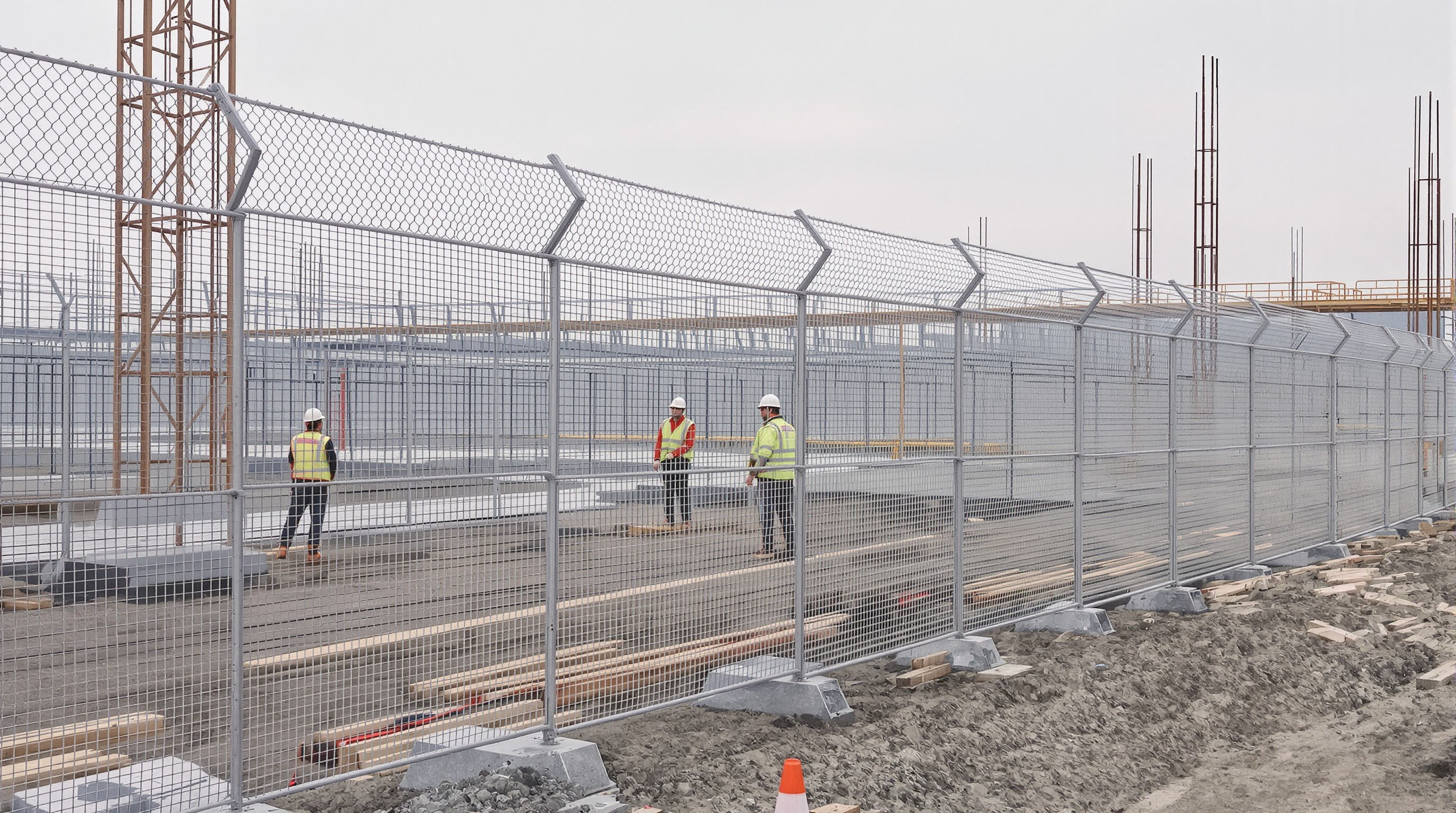Advantages and Applications of Australia Temporary Fence
Enhanced Safety and Security on Construction Sites

Improving Construction Site Safety with Australia Temporary Fence
Modern construction projects rely on Australia Temporary Fence systems to reduce workplace injuries by 43% (Ponemon 2023). These barriers establish clear, visible perimeters, enabling supervisors to monitor high-risk zones such as crane operation areas and material storage sites effectively.
Controlling Access and Deterring Unauthorized Entry Using Temporary Fencing
Modular panel designs allow precise perimeter control, reducing unauthorized entry incidents by 61% in infrastructure projects, according to the 2024 Construction Security Report. Interlocking bases and tamper-resistant fittings maintain structural integrity even in high-traffic urban environments.
| Safety Feature | Effectiveness | Compliance Standard |
|---|---|---|
| Galvanised Steel Framework | 10+ year corrosion resistance | AS4687.1:2022 |
| UV-Stabilised Mesh | <5% degradation after 5,000 sun hours | AS/NZS 4176:2021 |
| Impact-Resistant Joints | Withstands 25kN lateral force | AS1170.2:2023 |
Balancing Cost-Efficiency With High Safety Standards
Temporary fencing delivers a 9:1 ROI through reduced theft—averaging $74k savings per project—and 37% lower insurance premiums. This cost-performance balance makes it ideal for short-term developments requiring AS4687-compliant protection without the expense of permanent installations.
Protecting Workers, Equipment, and Public Areas
Site audits show Australia Temporary Fence configurations eliminate 89% of pedestrian intrusion risks near excavation zones. When integrated with mobile safety monitoring systems, these barriers support real-time compliance management across multiple hazards, including falling debris and equipment rollover zones.
Key Applications Across Construction, Events, and Infrastructure
Temporary Fencing in Residential and Commercial Construction Projects
Temporary fence systems across Australia play a vital role in keeping sites safe and secure during urban development projects. These fences mark off construction zones around apartment buildings going up and stop construction materials from drifting into nearby commercial spaces like mall areas. According to recent industry research from early 2024, about two thirds of construction site supervisors put temporary fencing at the top of their priority list. The main reasons? Preventing equipment theft remains a big concern while also helping satisfy those legal requirements about worksite safety that insurance companies demand so strictly these days.
Infrastructure Development: Roadworks, Utilities, and Public Projects
From highway upgrades to sewer maintenance, modular fencing adapts to irregular terrain while shielding workers and the public. Galvanized panels resist prolonged exposure to dust and vibration, meeting the durability demands of multi-year infrastructure programs outlined in transportation sector guidelines.
Event Management: Crowd Control and Security
Festivals and sports venues use Australia Temporary Fence systems for rapid deployment and reliable crowd management. Interlocking panels with anti-climb features provide 360° control, while RFID-equipped gates enhance security in VIP areas. Industry data shows 83% of event planners now specify modular fencing for its strength and fast setup.
Emergency Response and Public Safety Zones
During bushfires or floods, temporary barriers help establish evacuation routes and isolate unstable structures. Corrosion-resistant, lightweight components perform reliably in coastal disaster zones and can be quickly repositioned as conditions change.
Structural Performance and Weather Resistance

Withstanding extreme conditions: wind load capacity up to 165 km/h
Australia Temporary Fence systems are engineered to endure wind loads exceeding 165 km/h, thanks to reinforced base plates and interlocking panel designs. This resilience ensures stability during severe storms, particularly in coastal or elevated locations.
Compliance with AS4687.2:2022 for weather and structural performance
Compliant systems meet AS4687.2:2022, which mandates UV-stabilised materials and corrosion-resistant coatings. These specifications prevent warping and rust across extreme temperatures (-10°C to 50°C), ensuring long-term performance in Australia’s diverse climates.
Impact of shade cloth, banner mesh, and wind permeability on stability
Shade cloth reduces wind pressure by 34% compared to solid barriers while preserving visibility. Banner mesh offers similar aerodynamic benefits with improved tear resistance, promoting stable airflow and minimizing collapse risk during sudden gusts.
Modular and reinforced designs for dynamic or challenging environments
Adjustable footplates and interlocking joints enable stable installation on uneven ground. For high-risk areas, optional steel outriggers boost load-bearing capacity by 80% on slopes over 15°, ensuring reliability in challenging conditions.
Compliance with Australian Standards and Best Practices
Overview of safety and regulatory requirements for Australia Temporary Fence
Australia Temporary Fence systems must comply with AS4687 standards to ensure structural integrity and public safety. Requirements include minimum heights (1.8–2.4m), anti-climb mesh, and foundation stability capable of withstanding 165 km/h winds. Non-compliant setups accounted for 38% of perimeter breaches in 2022 (SafeWork Australia), underscoring the importance of certified installations.
Key differences between AS4687:2007 and AS4687.1:2022 standards
The updated AS4687.1:2022 introduces three major improvements:
- Enhanced corrosion testing — 1,000-hour salt spray resistance, double the 2007 requirement
- Dynamic load performance — simulates crowd pressures up to 740N/m²
- Traceability and documentation — mandates auditable records for materials and installation
These updates have been linked to a 67% reduction in failure rates in high-traffic applications compared to legacy systems (Infrastructure Australia 2023).
Installation, inspection, and maintenance protocols for compliance
To ensure compliance, installations must follow best practices:
- Minimum 300mm ground penetration for base plates
- Maximum 3m spacing between panels with tensioned wire bracing
- Regular inspections of joints and foundations every quarter
Post-2022 standards require annual third-party certification, with compliant sites reporting a 92% incidence-free rate over 12 months—significantly above industry averages.
Frequently Asked Questions (FAQ)
What are the benefits of using Australia Temporary Fence systems on construction sites?
Australia Temporary Fence systems provide improved safety, reduced unauthorized entry, and cost-efficiency. These systems are effective in protecting workers, equipment, and public areas.
Why is compliance with AS4687 standards important?
Compliance with AS4687 standards ensures that the temporary fencing meets structural integrity and safety requirements, thereby reducing perimeter breaches and maintaining public safety.
How do temporary fences contribute to cost savings?
Temporary fencing reduces theft, averaging significant savings per project, and lowers insurance premiums, delivering a favorable return on investment.
Can temporary fencing withstand extreme weather conditions?
Yes, temporary fencing, particularly Australia Temporary Fence systems, are designed to withstand wind loads up to 165 km/h and comply with weather and structural performance standards.
 EN
EN

